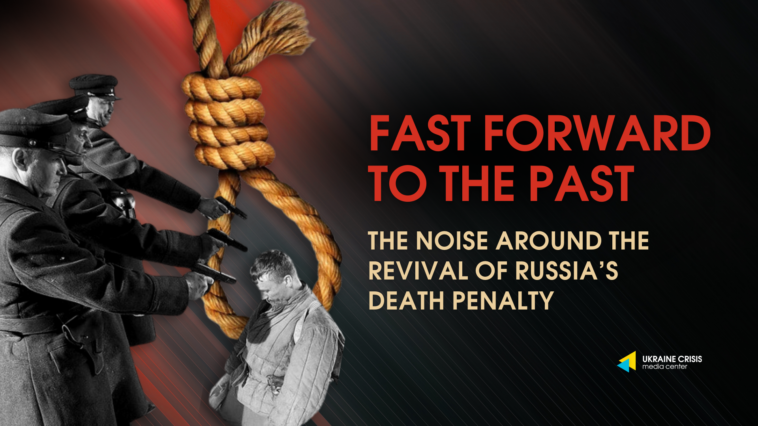Written by Anastasiia Ratieieva, UCMC/HWAG analyst
Following the Russian Volunteer Corps raid into Russia and ISIL’s terror attack on Crocus City Hall, the Russian establishment has called for the reinstatement of the death penalty. Putin addressed the issue of discrediting the Russian army in a speech delivered shortly after the presidential election and prior to the terror attack. Following the attack, this mention gained traction in Russian political and propaganda circles, despite the fact that the topic of discussion concerned an entirely different scenario. The discussions lasted several weeks until the Russian Federation’s Constitutional Court ruled that the official position could only be expressed at the president’s request.
But what does this loud debate signify?
The moratorium on the death penalty in Russia was de facto introduced in 1996 when it became a condition for the country’s acceptance into the Council of Europe. Before 1996, Russia operated under the Criminal Code inherited from the USSR. Under the Soviet Union, the death penalty could be imposed for 17 to 30 (depending on the republic) types of crimes during peacetime, including non-violent ones. According to scholars, during the post-Stalin period, the Soviet courts executed between 700 to 1000 people annually. The Kremlin’s criminal policy during Soviet times was repressively directed. Under the guise of “death penalty convictions,” the Soviet authorities subjected politically “undesirable” individuals to physical elimination. Modern Russia consistently proves its claim as a worthy successor to the USSR when it comes to totalitarian practices.
“It’s about time”
Both of the initial points of discussion about the death penalty—the Russian Volunteer Corps raid and the terrorist attack on Crocus City Hall—were framed by Russian propaganda as ideological confrontations with the Western world. “Are we playing European democracy here, which told us that the death penalty is bad… We’re dealing with traitors and murderers, and they should know that they shouldn’t try to surrender to captivity,” lamented Vladimir Soloviev about the Russian Volunteer Corps (RVC). Following the terrorist attack, propagandists claimed that Russia has left the Council of Europe and is no longer bound by any moratorium on executions.
The propaganda discussion imbued the political concept of lifting the moratorium with symbolism. Alexander Khodakovskiy (Telegram channel, 540,000 subscribers) was able to incorporate the theme into several narratives: “The Tsars of Russia and Rus chopped heads with an axe of those who, in their opinion, deserved execution.” It was not done for the sake of blood, but to demonstrate to the people that they are safe from external and internal enemies. Our country’s leader has the right to pardon, but he also has the right to take lives. And he should have the opportunity to do what the entire country expects of him: shed blood on the orders of the Supreme Commander-in-Chief.” Here is the historical significance of the practice, the protection of the people by a strong president, and the collective thirst for revenge.
Xenophobia was not spared: several propaganda channels proclaimed that “lifting the moratorium only for terrorists and foreigners is a great initiative!” The news that the Crocus Hall terrorists were Tatarstan citizens fueled Russian political circles’ chauvinistic tendencies once more.
One of Telegram’s Z-channels conducted a survey of its audience (453,000 subscribers), with 174,000 users participating. According to the results, which were later sent to the headquarters of the “United Russia” party with the request to “respond to the will of the people,” 82% voted to lift the death penalty moratorium.
Is the death penalty not a subject for discussion?
Loud announcements and statements can reveal how society will react to a specific political decision. The Kremlin is likely to view the lifting of the death penalty moratorium as an opportunity to strengthen the regime and counter opposition.
Statements from Russian media outlets citing Kremlin sources confirmed this hypothesis. Some argue that discussions about the death penalty, including those by Russian propagandists, are a “testing of public opinion.” Others claim that “there is demand in society.” The leader of the “United Russia” faction in the State Duma promised his constituents a debate and a decision “that will correspond to the sentiments and expectations of our society.” So, on the one hand, propaganda influences public opinion on the issue, while politicians and officials promise to take it into account.
In modern Russia, the fabrication of charges is common practice. Therefore, there is no doubt that the Russian regime may use physical means to “eliminate” a politically inconvenient person. In this case, legal and judicial procedures will provide cover for the death penalty.
This situation poses a direct threat to Ukraine, as it may have an impact on politically imprisoned individuals, particularly Crimean Tatars. Following the annexation of Crimea, members of the terrorist organization “Hizb ut-Tahrir,” which is banned in Russia but has legal status in Ukraine, were persecuted by Russian authorities. Given Russia’s history of false accusations and legal manipulation, the reinstatement of the death penalty creates even more political pressure.
Second, it could present a new military challenge for Ukraine. The Kremlin exploits the concept of terrorism, and Russian propaganda characterizes everything related to Ukraine as “terrorist.” Therefore, even a partial lifting of the moratorium on “the death penalty for terrorism” would allow Russia to use this measure against Ukrainian prisoners of war, and these calls have already been voiced in Russian propaganda circles.



